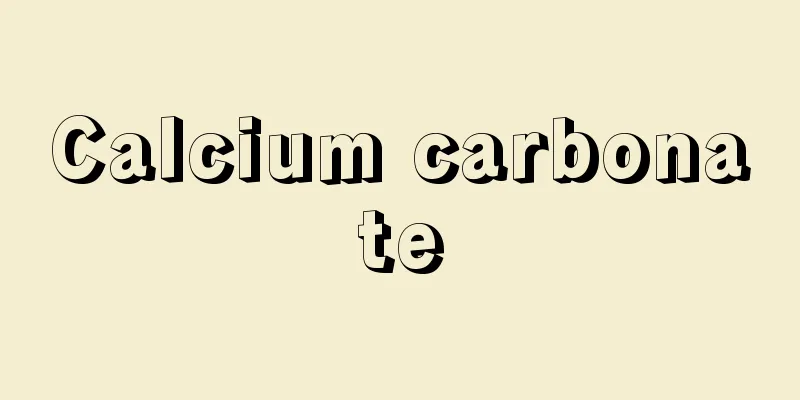Calcium carbonate

|
Calcium carbonate. In the industrial sector, it is also called calcium carbonate. It occurs naturally as ores such as calcite, marble, limestone, aragonite, and chalk. In industry, limestone is dry-crushed and the fine powder is collected by sieving or air elutriation (a powder separation process that utilizes the difference in the natural settling speed in the air) to produce the product (heavy calcium carbonate). It can also be produced by blowing carbon dioxide into milk of lime, drying and crushing the resulting precipitate (precipitated calcium carbonate or light calcium carbonate). It is also used when shellfish are wet-crushed (gofun). It is generally a white solid or colorless crystal. There are two transformations of the crystals. When heated, it dissociates according to the following reaction equation. This is an endothermic reaction. CaCO3CaO + CO2-42.0kcal CaCO 3 +CO 2 +H 2 OCa(HCO 3 ) 2 Limestone is used as a raw material for Portland cement and calcium oxide, marble is used as a building material, heavy calcium carbonate is used as a pigment and filler for paper and rubber, precipitated calcium carbonate is used in pigments, paints, paper and toothpaste, and chalk is used as a white pigment and water-based paint. [Torii Yasuo] Agricultural useIt is used to neutralize soil acidity. High purity calcium carbonate is suitable for pharmaceutical and industrial use, while calcium carbonate with relatively high impurities is used for agricultural purposes. It usually contains 53-60% alkali, and the coarser the grain size, the slower the rate at which soil acidity is corrected. Calcium carbonate is less basic than quicklime and slaked lime, but it is the most stable in the atmosphere and does not deteriorate during storage. Calcium carbonate colored black with carbon black has the effect of promoting snow melting, so it is used in early spring in cold regions such as Hokkaido. Calcium carbonate containing magnesium oxide (magnesium oxide) is called magnesium carbonate calcium carbonate, and is effective in acidic soils that are deficient in magnesium. [Yuki Koyama] [References] | | | | | | | | | | [Additional information] |Source: Shogakukan Encyclopedia Nipponica About Encyclopedia Nipponica Information | Legend |
|
炭酸のカルシウム塩。工業部門では炭カルともいう。天然には方解石、大理石、石灰石、あられ石、白亜などの鉱石として産出する。工業的には、石灰岩を乾式粉砕し、ふるい分けまたは風簸(ふうひ)(空気中での自然沈降速度の違いを利用する粉体分別操作)によって微粉を集め製品とする(重質炭カル)。石灰乳に二酸化炭素を吹き込んで生じた沈殿を乾燥、粉砕することによっても製造される(沈降炭酸カルシウムまたは軽質炭カル)。貝類を湿式粉砕したものも利用される(胡粉(ごふん))。一般に白色固体または無色の結晶。結晶には二つの変態がある。熱すると次の反応式に従って解離する。これは吸熱反応である。 CaCO3CaO+CO2-42.0kcal CaCO3+CO2+H2OCa(HCO3)2 石灰石はポルトランドセメント、酸化カルシウムなどの原料、大理石は建築材料として用いられる。重質炭カルは顔料、紙やゴムの充填(じゅうてん)剤に用いられ、沈降炭酸カルシウムは顔料、塗料、製紙、歯みがき粉に、胡粉も白色顔料や水性塗料に用いられる。 [鳥居泰男] 農業への利用土壌の酸性を中和することを目的に使用される。純度の高いものは薬品用、工業用に適するので、比較的不純物の多いものが農業用として用いられている。通常アルカリ分53~60%を含み、粒度の粗いものほど土壌酸性矯正速度が遅い。炭酸カルシウムは生石灰(せいせっかい)、消石灰よりも塩基性は弱いが、大気中での安定性がもっとも大きく、貯蔵中に変質することがない。カーボンブラックで黒く着色したものは融雪を促進する効果があるため、北海道などの寒冷地で早春に用いられる。なお酸化マグネシウム(苦土)を含むものは苦土炭カルといい、マグネシウムが欠乏している酸性土壌に効果がある。 [小山雄生] [参照項目] | | | | | | | | | | [補完資料] |出典 小学館 日本大百科全書(ニッポニカ)日本大百科全書(ニッポニカ)について 情報 | 凡例 |
Recommend
Satsuma Song
Ningyo joruri. Sewamono. 3 volumes. Kakugaki (Japa...
Moromiya Cho - Shokyucho
A type of narrative entertainment popular in the ...
bulky cargo
…As international trade became more active in the...
Industrial Education
It refers to education that teaches the knowledge...
Reeves, AH (English spelling) ReevesAH
…This type of conversion is called pulse code mod...
Vail, TN (English spelling) VailTN
…However, there were many disputes over Bell'...
Kishobori - Kishobori
...The custom of tattooing is said to have begun ...
Movie art - eiga bijutsu
A general term for all art involved in film produc...
Kitsuregawa Hills
A hill range in central Tochigi Prefecture, stretc...
Changcheng - Shojo
A county in the northern part of North Pyongan Pro...
Zdarsky, M.
…Northern European skiing techniques were then in...
Gyaling (English spelling)〈Tibetan〉rgyaling
A double-reed wind instrument used by Tibetan lama...
Zulu - Zulu
It is a Bantu language spoken from South Africa to...
delayed menarche
…Some scholars explain that menarche occurs when ...
Rice weevil - Rice weevil
It belongs to the family Curculionidae in the orde...









